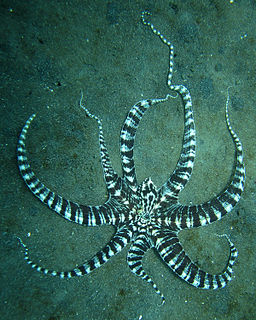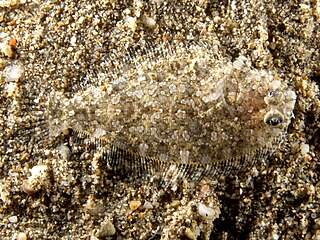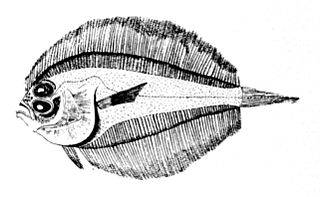
The mimic octopus is an Indo-Pacific species of octopus capable of impersonating other local species. They are notable for being able to change their skin color and texture in order to blend in with their environment, such as algae-encrusted rock and nearby coral through pigment sacs known as chromatophores. The mimic octopus possesses chromatophores as well as the unique behavior of taking shape of various objects and animals. The mimic octopus is the only currently known marine animal to be able to mimic such a wide variety of animals. Many animals can imitate a different species to avoid or intimidate predators, but the mimic octopus is the only one that can imitate as diverse a range of forms in order to elude predators.

Pleuronectidae, also known as righteye flounders, are a family of flounders. They are called "righteye flounders" because most species lie on the sea bottom on their left sides, with both eyes on their right sides. The Paralichthyidae are the opposite, with their eyes on the left side. A small number of species in Pleuronectidae can also have their eyes on the left side, notably the members of the genus Platichthys.

The Samaridae are a family, the crested flounders, of small flatfishes native to the Indo-Pacific. They were formerly classified as a subfamily of Pleuronectidae. The family contains four genera with a total of almost 30 species.

Platichthys is a genus of flatfish native to the North Pacific and North Atlantic oceans. Despite being in the family Pleuronectidae, both species in the genus Platichthys are often "lefteyed", i.e. they lie on the sea bottom on their right side, with both eyes on the left side.
Nematops is a genus of righteye flounders native to the Indo-West Pacific. Due to their small size and depth of habitation few examples of this genus are caught, and as a result little is known of their morphology and distribution.

Poecilopsetta is a genus of small righteye flounders mainly found in deep water in the Indo-Pacific. Two species, P. beanii and P. inermis, are from the West Atlantic.

The Citharidae or largescale flounders are a small family of flounders with four genera. Three genera are restricted to the Indo-Pacific, while Citharus is from the Mediterranean and East Atlantic. There are a total of seven species. Species reach lengths ranging between 14 and 36 centimetres.

Bothus is a genus of flatfish in the family Bothidae from the Pacific, Indian and Atlantic Oceans. Some species in this genus have spots consisting of blue rings.

The scaldfishes comprise a genus, Arnoglossus, of lefteye flounders. They are found in the Pacific, Indian and Atlantic Oceans, including the Mediterranean and Black Sea. They are entirely absent from most of the Americas; the only exceptions are A. coeruleosticta and A. multirastris found off Chile. The genus include both species found in shallow and deeper water. The largest species reaches 28 cm (11 in).

Asterorhombus is a genus of lefteye flounders native to the Indo-Pacific. These small flatfishes only reach 20 cm (7.9 in) in length.

Engyprosopon is a genus of small lefteye flounders. They are found in the Indo-Pacific, ranging from shallow coastal waters to depths in excess of 400 m (1,300 ft).
Grammatobothus is a genus of small lefteye flounders native to the Indo-Pacific.

Laeops is a genus of small lefteye flounders from the Indo-Pacific. They are mainly found in deep water, although a few species have been recorded shallower than 100 m (330 ft).

Psettina is a genus of small lefteye flounders native to the Indo-Pacific.
Brachypleura novaezeelandiae, the yellow-dabbled flounder or yellow citharid, is a species of citharid flounder native to the western and central Indo-Pacific. It occurs at depths from 18 to 92 m and is of minor importance to commercial fisheries. This species grows to a length of 14 cm (5.5 in). This species is the only known member of the genus Brachypleura.

Pseudorhombus is a genus of large-tooth flounders. With the exception of P. binii found off Peru, species in this genus are native to the Indo-Pacific. The largest species reaches 40 cm (16 in) in length.

Syacium is a genus of large-tooth flounders found in the Atlantic and Pacific Oceans. With the exception of S. guineensis from the Atlantic coast of Africa, all species are from the Americas. The largest species in the genus reaches 40 cm (16 in) in length.

Samaris is a genus of crested flounders native to the Indo-Pacific.

Samariscus is a genus of crested flounders native to the Indo-Pacific.


















